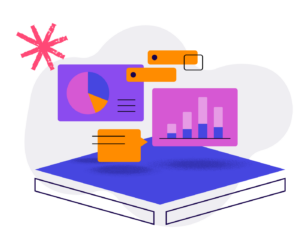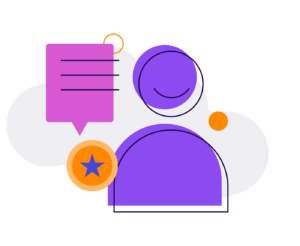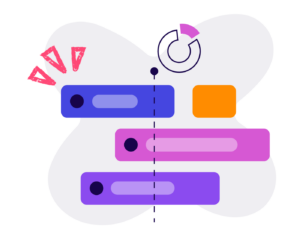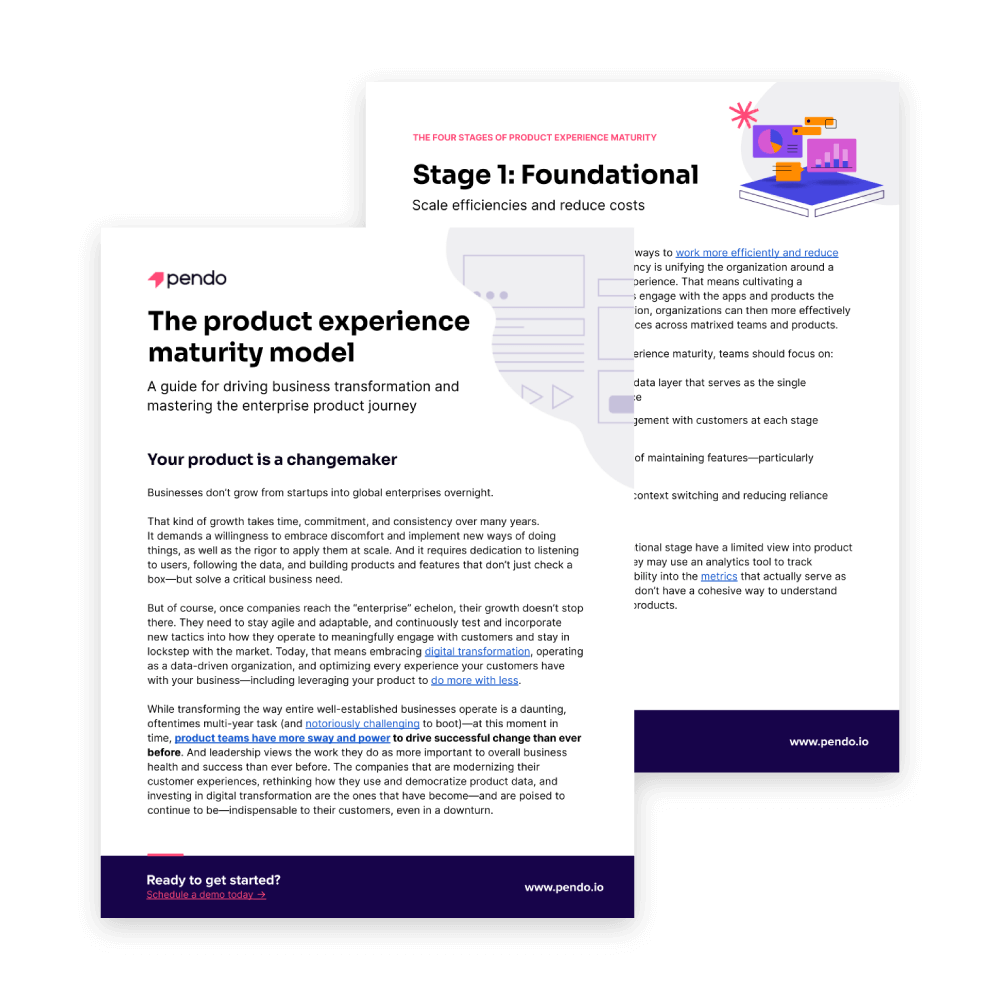
Table of Contents
In a rush?
Download the PDF for later
Your product is a changemaker
Businesses don’t grow from startups into global enterprises overnight.
That kind of growth takes time, commitment, and consistency over many years. It demands a willingness to embrace discomfort and implement new ways of doing things, as well as the rigor to apply them at scale. And it requires dedication to listening to users, following the data, and building products and features that don’t just check a box—but solve a critical business need.
But of course, once companies reach the “enterprise” echelon, their growth doesn’t stop there. They need to stay agile and adaptable, and continuously test and incorporate new tactics into how they operate to meaningfully engage with customers and stay in lockstep with the market. Today, that means embracing digital transformation, operating as a data-driven organization, and optimizing every experience your customers have with your business—including leveraging your product to do more with less.
While transforming the way entire well-established businesses operate is a daunting, oftentimes multi-year task (and notoriously challenging to boot)—at this moment in time, product teams have more sway and power to drive successful change than ever before. And leadership views the work they do as more important to overall business health and success than ever before. The companies that are modernizing their customer experiences, rethinking how they use and democratize product data, and investing in digital transformation are the ones that have become—and are poised to continue to be—indispensable to their customers, even in a downturn.
The product experience maturity model is a framework to guide and empower product teams to lead change and digital transformation in their organizations, while optimizing the product experience and driving growth for the business. Think about it as a hierarchy of needs: By understanding what each stage of maturity looks like—and how to leverage product experience tools like Pendo to improve how you and your product function at each step—you’ll be better able to delight your customers and slingshot your entire organization into its next stage of growth.
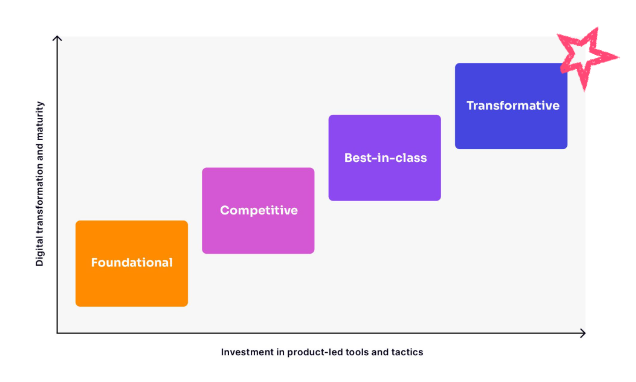
Stage 1 — Foundational
Scale efficiencies and reduce costs
More than ever before, companies must find ways to work more efficiently and reduce operational waste. A pillar of business efficiency is unifying the organization around a single source of truth about the customer experience. That means cultivating a data-driven understanding of how customers engage with the apps and products the company produces. Armed with this information, organizations can then more effectively measure—and influence—customer experiences across matrixed teams and products.
So, in the foundational stage of product experience maturity, teams should focus on:
- Building a foundational, democratized data layer that serves as the single source of truth for product performance
- Using in-app messaging to drive engagement with customers at each stage of the journey
- Understanding the cost-to-value ratio of maintaining features—particularly those that are unused or underused
- Increasing productivity by eliminating context switching and reducing reliance on engineering resources
Most large organizations entering the foundational stage have a limited view into product engagement across their portfolios. While they may use an analytics tool to track high-level stats like pageviews, they lack visibility into the metrics that actually serve as indicators of user health and happiness, and don’t have a cohesive way to understand how their users move through and between products.
Access to this data can also be restricted—living in data lakes where very few teams are able to access and understand it to inform their decision-making, and making it impossible for non-technical teams to consume. This means the various teams that touch the product end up working with inconsistent access to critical data values. And without a shared knowledge of the customer or employee journey, the end product delivers a conflicting and disjointed user experience.
Oftentimes, product teams are also heavily reliant on engineering to make changes (no matter how big or small) to the product. Without access to self-service in-app messaging tools, product teams can’t deliver timely guidance to customers or employees, disseminate updates that could benefit the entire user base (or even just a segment of affected users), or provide proactive support to struggling users. Instead, they’re forced to wait for the next scheduled development release to request such changes or additions. In the meantime, they face a flood of support tickets and requests from disgruntled users—most of which could have been mitigated with a simple in-app alert.
Operationally, teams throughout foundational-stage enterprises are likely to spend a lot of time in 1:1 engagements with customers—regardless of the value of those accounts. For example, customer success managers (CSMs) and onboarding specialists may spend hundreds of hours helping customers with routine activities like new user onboarding or basic product walkthroughs—taking away time and attention they could be devoting to more bespoke services for their highest-value relationships.
Finally, foundational stage organizations typically have no way of identifying which products or features in their portfolio are actually driving value for the business vs. which are underutilized and prime candidates for sunset. This leads to an excess of time, effort, and resources being wasted on the parts of the product that don’t actually move the needle.
With a foundational product experience, you’ll be able to:
- Identify value drivers within your product
- Quantify resource investment
- Standardize product KPIs across the business
- Increase clarity across applications on ROI
- Create clear objectives for experiments and initiatives
Key tactics:
- Create a foundational data strategy by using product analytics tools to get closer to users and understand how they’re moving across and within products and features. If you’re using a solution like Pendo, establish a “power team” to lead the effort of standardizing visitor and account metadata, tagging pages and features as needed, standardizing product KPIs, and reporting in Pendo and across the organization.
- Nurture customers within your product or app using targeted in-app guides to drive engagement in the moments that matter. This will help reduce reliance on your customer-facing teams and improve the overall product experience.
- Create an accessible help center. Identify commonly requested resources or frequently asked questions, and make them available within your products in a centralized, in-app hub. This will also help deflect routine support tickets and empower your users to self-serve.
Stage 2 — Competitive
Increase customer retention and loyalty
Once your foundational data layer has been established, it’s time to focus on increasing customer retention and loyalty by engaging with users in more meaningful ways, when and where it matters most: inside your products.
In the competitive stage of product experience maturity, teams should focus on:
- Nurturing users to the features that are most likely to deliver value
- Anticipating needs and guiding users through personalized onboarding
- Improving engagement by setting KPIs around stickiness (which results in a reduction in churn)
- Cultivating your users into advocates
Competitive-stage teams advance from establishing a solid foundational data layer to having a comprehensive view into user engagement across their various apps and product lines. They have clear KPIs and dashboards in place to measure success (and frequently derive actionable insights from them), democratizing data throughout the organization. They also share this data across product teams to help eliminate silos and encourage different business units to learn from each other. This creates a common language and—particularly for companies with large product portfolios—makes it easier for disparate teams to build more cohesive, user-friendly multi-product journeys.
Organizations at this level of maturity also continue to build off the work they started in the foundational stage to deepen their understanding of where they should spend their time and resources. They evaluate product and user engagement data to make informed decisions about which features or products to sunset, or which to invest more heavily in. These insights give product teams confidence in what they’re building and help them prioritize the initiatives they know will have the greatest impact on the business.
Most competitive-stage companies use in-app content to engage with a broad audience of users inside their products. They also leverage segment- and behavior-based guidance to further tailor their communications. By using product data to identify which users to engage with—and when—PMs, CSMs, marketers, and salespeople can reach the right users at the right time using personalized messaging that drives desired behaviors and deepens account penetration.
With a competitive product experience, you’ll be able to:
- Better align your product experience with business needs
- Leverage an omni-channel strategy to engage with your users at the right moment
- Standardize data models across your product portfolio
- Consistently leverage data to inform decision making
Key tactics:
- Leverage product analytics to identify features or apps driving meaningful user engagement to help determine where to invest or divest budget and resources.
- Use segmentation to target key cohorts of users to analyze behavior and target in-app guides.
- Enable the right teams within your business with product analytics reporting on an ongoing cadence—to enable data-driven decision-making and clearly tie findings to business outcomes.
- Assemble an in-app guide governance team and create documentation to provide oversight, mitigate redundancy, and ensure consistent standards are met whenever in-app guides are deployed.
Stage 3 — Best-in-class
Drive revenue from digital engagement
Companies that reach the best-in-class stage of product experience maturity are well on their way to automating many of the routine processes that once hindered efficiency and ate up their team’s time and energy.
At the best-in-class stage of product experience maturity, teams should focus on:
- Aligning cross-functional teams around shared goals for user engagement, feature adoption, and ongoing retention
- Articulating how their product initiatives contribute to driving revenue growth
- Leveraging user- and behavior-based data values to automate personalized experiences based on each customer’s stage in the journey
Best-in-class organizations have a sophisticated understanding of product data and are able to attribute revenue to specific product initiatives. And they use data-informed in-app communication strategies to increase efficiency and grow profitability throughout the user journey.
Companies at this level of maturity also recognize their product experience as central to the overall customer experience. They empower their users to be more productive by bringing key touchpoints and resources—like education and user sentiment measurement—directly inside the product. By doing so, they no longer need to rely on outbound channels to drive critical engagement with customers, saving costs and freeing up internal teams to work on more strategic initiatives.
As they scale their product experience initiatives, best-in-class-stage organizations evolve their “power team” into a center of excellence (COE) to provide oversight over all their product-led initiatives across the product organization. This cross-functional group champions the product experience, advises on best practices, and upholds clear governance standards around activities like in-app guidance and reporting.
With a best-in-class product experience, you’ll be able to:
- Leverage data about your users and their behavior to personalize and automate their journey
- Use behavior-based triggers to drive deeper engagement
- Consistently connect product usage data to retention, upsell, and cross sell strategy
- Holistically use both quantitative and qualitative insights to measure customer health and inform broader customer experience initiatives
Key tactics:
- Integrate your product experience system of record with other key tools used throughout the organization, so that your product data becomes the driving force behind all decisions—and so you can see how your product directly impacts profitability.
- Build a scalable in-app personalization strategy using product data and segmentation. Drive all key customer touchpoints inside the product to reduce friction and accelerate sales cycles.
- Leverage feature adoption data to automate associated customer touchpoints in order to connect key stages of the journey.
Stage 4 — Transformative
Innovate faster and with higher ROI
Companies operating at the transformative stage of product experience maturity deliver a seamless user journey within and across their apps and products, and operate at the highest levels of efficiency. They have built a strong, digital-first culture that puts their products at the center of their customer experience, and leverage product data to make informed decisions that drive the business forward.
At the transformative stage, teams should focus on:
- Building the roadmap based on customer inputs, with direct connection into downstream revenue impact
- Combining product and usage data from the customer journey with critical data values from other systems to align product initiatives to key stages of business growth
In transformative-stage enterprises, teams working on different apps and product areas across the organization share a single source of truth for product data. These key data values are fully integrated with the rest of their tech stack, allowing them to easily correlate quantitative performance metrics with qualitative feedback—and making it seamless for them to identify areas of opportunity, spot trends, and close the loop with users.
These initiatives play a critical role driving the company’s overarching transformation strategy by championing scalable and automated strategies that drive cross-functional efficiencies, reign in sprawl, consolidate spend, and reduce costs.
With a transformative product experience, you’ll be able to:
- Integrate product user behavior data with other business-critical data values to create a unified view of the customer experience—and business impact
- Operationalize and standardize how teams across your organization leverage data to improve the product and customer experience
- Accelerate product development, deployment, and adoption
Key tactics:
- Automate and connect feedback loops between your product and business teams
- Integrate your product user behavior data with your broader tech stack
- Consistently operate with a holistic, 360º view into the customer journey
Ready to build better product experiences, at scale?
- Learn four ways your product can accelerate your business in this report
- Hear first-hand perspectives from leaders and practitioners in companies who are prioritizing their product experience in the top 10 product-led talks of the year video series
- Find out how becoming product led improves every aspect of the customer experience (and how to get started) on the Product-led Hub
- See some of the amazing things our customers have achieved by using Pendo to power their product-led strategy
- Request a custom demo to find out how Pendo can help you digitally transform your business and improve your product experience
